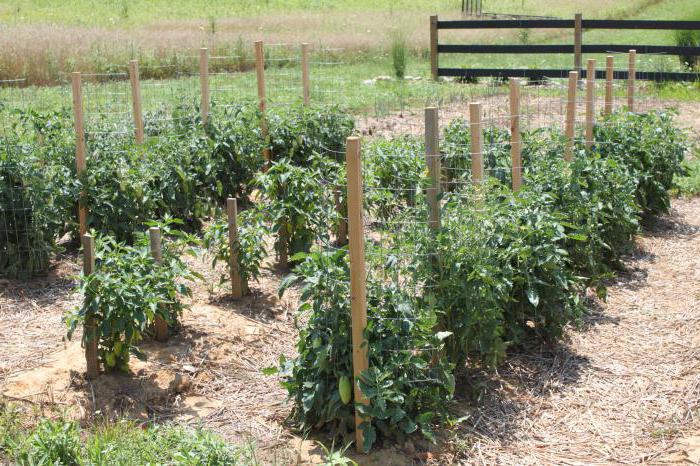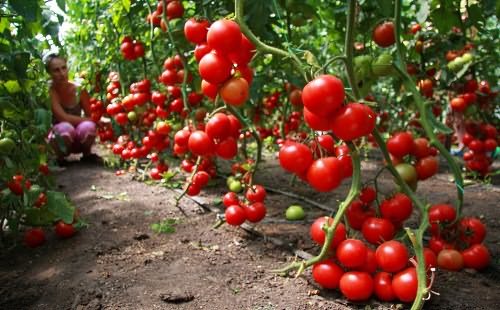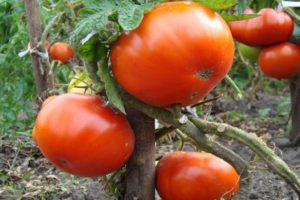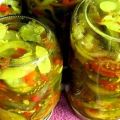Characteristics and description of the Diabolic tomato variety, its yield
Tomato Diabolic F1 is a mid-season variety. Bred by Sakata agronomists. Included in the State Register of Breeding Achievements of Russia in 2008. The bushes are medium in height, determinant, that is, they stop growing when blooming. Suitable for planting on a plot and in a greenhouse.
Description of bushes
Characteristics of the bushes: powerful, many leaves, 1.2 - 1.6 m high. Plants must be tied to pegs and cut off by stepchildren. One cluster contains 8 - 12 fruits. It is better to leave 2 - 3 stems in the variety, cut off the rest. Medium-sized greenish leaves. The inflorescence is complex. The fruits of this variety are eaten fresh, canned, pickled.
Description of fruits
Description of Diabolic tomatoes: they have the shape of a slightly elongated cream, weighing 100 - 160 g. Unripe tomatoes are light green, and ripe ones are scarlet, the shade of the pulp is dark pink. Tomatoes have 3 - 4 seed chambers. The fruits are quite light.
Tomatoes are salted and pickled, put in salads. The composition of the fruits: dry matter in juice 5.0 - 7.2%, sugars (glucose, fructose, sucrose) - 3.0 - 3.9%. Tomatoes cannot be called too sweet, but they are also bland. The seeds are sold by the companies Gavrish, Agros, Prestige.
Pros and cons
Tomato Diabolic F1 has several advantages:
- Tomatoes do not crack, lie well, and are easy to transport. They have firm flesh.
- Many fruits are harvested from the bushes: regardless of the weather conditions, the yield is from 1 m² to 20 kg, 256 - 296 centners are harvested per hectare.
- Features of the variety - immunity to verticillium and fusarium, phomopsis and bacterial spotting.
- Diabolic F1 tomato is not attacked by root nematode.

Of the shortcomings, it is worth noting that for planting seedlings it is advised to choose the most well-lit place. Even a little shading will result in less harvest.
Sowing seeds
Diabolic tomato cultivation begins with sowing seeds. The seeds of the variety are sown in mid-March. Place the seeds in a cheesecloth bag and then set aside for 20 minutes. in a weak solution of potassium permanganate, then rinse. Then you can soak the seeds in a growth promoter. Agave juice produces a wonderful effect on tomato seedlings: place the seeds in a cloth bag and immerse them in a solution of aloe juice with water for 1.5 hours, then dry them. Agave juice increases seed germination by 25%, they germinate faster.

Pour grocery store-bought tomato potting soil into the crates. Compact the soil and water liberally. Make grooves every 4 - 5 cm and to a depth of 1 cm. After a day, sprinkle the seeds on the ground so that there is a distance of 2 cm between them. Powder with soil, cover with foil, place in heat. When you see the sprouts, remove the film, expose the plantings to the light.
When 2 true leaves appear, dive the seedlings.Pour a little superphosphate into each glass before placing the seedling. Pinch the root a little.
Soil preparation
Do not plant seedlings in the place where potatoes, eggplants, and peppers used to grow. Plant Diabolic F1 tomatoes in the area where cabbage, onions, and cucumbers grew last year.
In autumn, sprinkle 5 kg of humus, 50 g of superphosphate, 25 g of potassium salt per 1 m² of soil, dig up the ground on a shovel bayonet, remove roots, weeds. In the spring, scatter 1 kg of rotted poultry manure, 1 kg of ash and 25 g of ammonium sulphate per 1 m², dig up again. Drive in stakes near the beds, tie up the wire to make trellises.

To prevent the tomatoes from getting sick, spill the soil a few days before planting the seedlings with the following composition: pour 30 g of 90% copper oxychloride into a 10-liter bucket of water, pour the composition onto the site.
Landing on the site
Tomato Diabolic F1 does not tolerate return frosts, because of this, plant seedlings from May 15. Pull holes with a diameter of 15 cm and a depth of 20 cm, making a gap between them of 40 cm, and between the rows - 60 cm. Water the seedlings abundantly a day before transplanting. Remove the seedling with a lump of soil, place it in the hole. Cover with earth, water, shade from the sun. Cover the ground with straw, peat.
Care
Tomatoes do not like drought and stagnant moisture. Water the bushes in the morning at the root, trying not to get on the leaves, otherwise the seedlings can get sick with late blight. The water is used warm, which has stood for at least a day. At first, watered moderately, and in summer - abundantly. Water stagnation should not be allowed. The next day, the soil is loosened, weeds are pulled out. Water the next time when the soil dries up.
First, they are fed after planting seedlings, then a second time when buds begin to appear. The third time they feed when the flowers wither and the appearance of ovaries, the fourth - when fruiting. The fourth dressing is done 2 weeks before picking up the fruits.
The one who planted the variety advises to feed the seedlings with a solution of bird droppings for the first time: first, add 25 g of droppings in 0.5 liters of water, then add 5 g of potassium sulfate and 20 g of superphosphate each, then pour the composition into a ten-liter bucket of water. Pour this dressing under the root (1 liter per bush).
When the buds appear, repeat the feeding. You can replace this dressing by adding 1 tbsp. spoon nitrophoska into a ten-liter bucket of water and pouring 1 liter of the mixture under each seedling.
So that the bushes do not have apical rot, make a solution of 1 tbsp. tablespoons of calcium nitrate and a ten-liter bucket of clean water. Spray the crop with this solution when it blooms. Pour 1 liter of solution on each bush.
When the first ovaries begin to appear, make a solution with wood ash. Pour 2 liters of ash, 10 g of boric acid into a ten-liter bucket of clean water. Leave it on for a day to dissolve the elements. Water at the root, pouring 1 liter per bush.
Do the fourth feeding when the fruits are poured, Pour in 2 tbsp. tablespoons of superphosphate, 1 tbsp. a spoonful of potassium humate in a ten-liter bucket of water. Pour 1 liter under the bush. Form a bush, leaving 2 - 3 stems, cut off the rest.
The hybrid is easy to care for. The reviews are good. So, Tatiana from Moscow writes: “I really like the Diabolic tomato variety. I have been planting bushes for 3 years. The taste is harmonious, has a sweetness with some sourness, the variety is very fruitful. Late blight was not sick. "
Those who planted Diabolic F1 tomato find this tomato variety quite hardy and high-yielding, suitable for both experienced gardeners and beginners.









